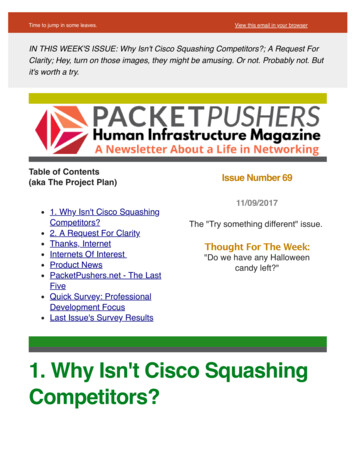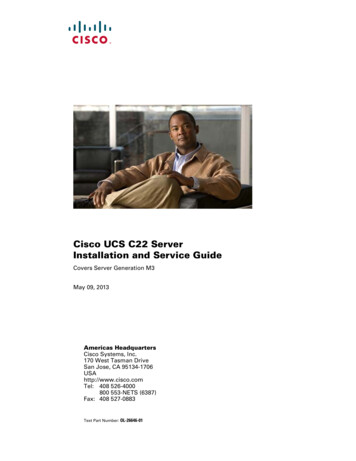
Transcription
Time to jump in some leaves.View this email in your browserIN THIS WEEK'S ISSUE: Why Isn't Cisco Squashing Competitors?; A Request ForClarity; Hey, turn on those images, they might be amusing. Or not. Probably not. Butit's worth a try.Table of Contents(aka The Project Plan)Issue Number 6911/09/20171. Why Isn't Cisco SquashingCompetitors?2. A Request For ClarityThanks, InternetInternets Of InterestProduct NewsPacketPushers.net - The LastFiveQuick Survey: ProfessionalDevelopment FocusLast Issue's Survey ResultsThe "Try something different" issue.Thought For The Week:"Do we have any Halloweencandy left?"1. Why Isn't Cisco SquashingCompetitors?
by Greg FerroCisco is a sales bulldozer that crushes competition by making itdifficult for customers to NOT buy Cisco products.Let’s be honest: Cisco's technology isn't the best, its software quality ispoor, bug fixes take months, and it’s slow to add features. Yet thisdidn’t stop Cisco from outselling competitors for the last decade.Following Not LeadingCisco's mode of 'innovation' is to buy successful companies. Thisinstant innovation is much cheaper than internal research anddevelopment.After Cisco makes a purchase, it adds the product to its supermarket.For example, Viptela’s SD WAN goes next to the ever popular branchrouters, just above the branch switches, and down the aisle frombranch security.This business model was a winner for John Chambers' Cisco, but it’snot working so well now. Why?Speed Of ChangeNetworking didn't change much from 1999 to 2012 or so. Same routingprotocols, same basic designs, and customers didn't really want toinvest in networking except to go faster by moving from 100Mbps to1Gbps.We dropped fewer packets as silicon got faster, but the software andfeatures were basically unchanged. This slow moving market wasgood for Cisco’s sales only focus; customers kept buying the sameproducts, and deploying the same designs.
At the same time, Cisco did very little to modernize and it avoidedresearch and development.In last five or so years, dozens of networking startups have emergedacross a wide range of the market. The first startups were attracted tothe 80% gross profit margins of everyday products like campusswitches and branch routers (see SD WAN).Startups can move quickly, going from concept to product in as little astwo years. This is about the same amount of time it would take to get aconcept project approved internally at Cisco, much less bring aproduct to market.Anti-AutomationCisco has many business units (BUs) internally, and each is ruthlesslyfocused on its own profits. Cisco pays generous bonuses when yourBU exceeds targets. So it’s not a surprise that some BUs want to bringnew products to market, but existing BUs fight hard to prevent them.Cisco's slow acceptance and implementation of automation is keyhere. Many BUs simply refused to implement automation because itwas seen to impact their own profits.If they did bow to customer pressure, each BU acted independentlyand often with low quality. It’s a simple trick to under resource a projector allocate your worst people to something you don't like.But automation is now required if enterprise networks are to keep upwith the accelerated pace of application deployment. Only recently hasCisco converged on a single YANG model. Mandatory implementationfor automation and rumors of direct CEO intervention abound.Sales FirstCisco is a "sales first" culture where the "deal" is everything andsuccess is measured by the dollars sold this quarter. Change causes
sales to slow down. You can see the problem.Sales first cultures have problems when the products keep changingor when competitors have better technology or a better story. Theability to close deals relies on sharp business practices like creatingartificial pricing schemes (list vs. street price) to create reasons toengage sales.Cloud has changed this. Self service models of limited but clearlydefined products don't need expensive sales humans.Commodity ProductsIn addition, people realize that that sales don't add value. Why wastehundreds of hours working on complex licensing and hardwarecomparisons? Buy it from a website and move to the next problem.It’s now true that Cisco is only one of many suppliers for hardware andsoftware for networking. Indeed, savvy customers are building theirown solutions with automation to avoid having to deal with vendors.Cisco Is Trying To ChangeThere's no question Chuck Robbins is forcing change at Cisco. He ismerging BUs and forcing them to cooperate instead of compete (forinstance, ACI was merged into single Data Center BU).He’s overhauling stale product lines, launching initiatives such as SD Access, and moving rapidly into new markets like IoT as Enterprise ITshrinks.Cisco has a mixed record of being successful at change; in my view itgets about half of new efforts right. That’s why I'm standing back andwaiting to see signs of success before I would commit to Cisco as asingle source vendor.
2. A Request For Clarityby Drew Conry-MurrayThe other day I was researching a product for a blog I was writing.After twenty or so minutes on the Web page, I still had no clear ideawhat the product did or how it worked.Like a fortune teller reading entrails, it was up to me to make senseout of a bloody mess of the marketing grizzle strewn among the bonesof “intent” “automation” and “machine learning.”And then I realized that was the point.If, like a fortune, a vendor’s language is broad enough and vagueenough, it can encompass just about any problem a potentialcustomer is trying to solve.The language that vendors use on their Web pages isn’t meant toinform. It’s meant to entice me into further contact and turn me into alead.I can’t get my question answered until I hand over some contactdetails, which starts me down a sales funnel like a pig through a chute.Good Leads And LeadershipI get that vendors need to sell products. They have employees to pay,facilities to operate, and shareholders to satisfy.And I understand that to sell products, vendors need to keep the salespipeline flowing with leads.But are 100 crappy leads from confused and irritated engineers moreworthwhile than 3 or 4 strong leads from engineers who actually know
what your product does and want to find out more?Are you enhancing anyone’s productivity—your employees’ or yourpotential customers’—by sitting through innumerable calls, meetings,and white board sessions just to find out you’re not really a fit?Tech organizations are always looking for ways to be thought leaders.Well, here’s a great opportunity:Demonstrate industry leadership by jettisoning all marketing bullshitand buzzword washing. Commit to clear, descriptive language whendescribing your product or service.It might mean a smaller pipeline, but also one that requires lessfiltering of crap and waste. Isn’t that better for everyone?Thanks, InternetAll kinds of amusing things wash up in our social feeds. Here'sone that caught my eye.
Join the Packet Pushers' new membership program and get benefitsincluding our weekly Link Propagation newsletter and more. Click herefor details and to sign up.Internets Of InterestA collection of pre-loved links that might interest you. "Pre-loved"because I liked them enough to put into this newsletter. It's not true love.By Drew Conry-MurrayThe Three Paths Of Enterprise ITIvan Pepelnjak posted a blog that speculates on the different waysenterprise networking could diverge in the coming years:Those who move primarily into public cloudThose who adopt a hyperconverged/private cloud
Those who control their own destiny by investing in networkingsoftwareWhat path are you on?LINKLooking Back At Questions About IPNetworkingRuss White takes a journey to the (recent) past to look at a 2003technical paper from the Association for Computing Machinery (ACM)entitled "Will IP really take over the world (of communications)?"Russ notes the paper's conclusion that packet switching is superior tocircuit switching and then examines the reasons for this conclusion tosee if they hold true today.LINKThe Cure For Revenge Porn: Send Nude Pics ToFacebook?Revenge porn, in which a disgruntled a**hole posts nude images of anex online, is a reprehensible crime. It's also difficult to prevent becausedigital images are easy to copy and share.Now the Australian Broadcasting Corporation reports on a partnershipbetween Facebook and an Australian government agency with a trialsolution:
Send your nude pics or videos to yourself via Facebook's Messengerapp. Facebook will run the images through an algorithm to generate ahash value, and block content with the same hash value from beingposted on Facebook, Instagram, and Messenger.The government agency in the article claims Facebook won't store theimages or videos.OK, I get the concept behind this idea, and I'm glad Facebook takesthe problem seriously. But I have a hard time trusting the security ofthis content with Facebook. It seems both counter intuitive anddownright creepy. Am I wrong here?LINKJoin the Datanauts on their missionto bust silos and explore the latestdevelopments in cloud,convergence, data centers, andmore. Sign up free here.Network Break is a weeklypodcast that delivers news &analysis on the networking industryin a fun, fast paced style. Subscribehere!
Product NewsFind out about interesting new products, or get essential informationabout things you might already be using.ThousandEyes’ New Device Layer IntegratesSNMP With Performance MonitoringThousandEyes has announced a new capability for monitoringnetwork performance. Called Device Layer, the new capability usesSNMP to collect data on routers, switches, APs, firewalls, and othernetworking gear.The company integrates this data with the agent based active testing itperforms to give administrators and operators more visibility into thenetwork and more context to measure performance and identify theroot cause of problems.LINKBarracuda Networks Adds DDoS Protection ToIts Web Application FirewallBarracuda Networks has added a new DDoS protection service to itsWeb Application Firewall (WAF). The new feature, called Active DDoSPrevention (ADP), is designed to filter out volumetric attacks againstWeb application targets.LINK
Briefings In Brief: A New Packet PushersPodcastWant more tech news? Subscribe to our newest podcast channel,Briefings In Brief. We take five minutes or less to summarize andanalyze tech news, product announcements, or other interesting itemsthat come across our desks.LINKRecent PodcastsThe last five podcasts published on Packet PushersPacketPushers.net - The Last FivePQ 135: Mastering Python Networking – The BookDatanauts 109: Run VMware Apps In The Cloud With Ravello (Sponsored)Network Break 160: VMware Buys VeloCloud; Qualcomm Sues AppleShow 364: ThousandEyes Adds Infrastructure Visibility (Sponsored)PQ 134: Meet ZeroTier – Open Source Networking
Full Stack Journey tells personalstories about the ongoing quest tobecome a full stackengineer. Subscribe today!Priority Queue tackles niche andnerdy tech topics and cutting edgeresearch projects. Subscribe here!Quick Survey: ProfessionalDevelopment FocusA lot of IT pros invest personal time and money on professionaldevelopment. Where are you putting the majority of your efforts?A. Automation/Coding/ScriptingB. Business study/MBAC. Certification in my primary fieldD. Certification in a secondary fieldE. Self directed study (i.e. a bit of this, a bit of that)F. Other
Last Issue's Survey ResultsDid We Miss Something?Got an link or an article to share? Email it tohumaninfrastructure@packetpushers.netThe End BitSponsorship and Advertising - Send an email to humaninfrastructure@packetpushers.net for more information. Youcould reach 5,013 people.Human Infrastructure is bi-weekly newsletter with view, perspectives, and opinions. It is edited andpublished by Greg Ferro and Drew Conry-Murray from PacketPushers.net. If you'd like to contribute, emailDrew at drew.conrymurray@packetpushers.net.We don't give away your email address or personal details because that would suck.
Copyright 2017 Packet Pushers Interactive LLC, All rights reserved.unsubscribe from this listupdate subscription preferences
Barracuda Networks Adds DDoS Protection To Its Web Application Firewall Barracuda Networks has added a new DDoS protection service to its Web Application Firewall (WAF). The new feature, called Active DDoS Prevention (ADP), is designed to filter out volumetric attacks against Web application targets. LINK











